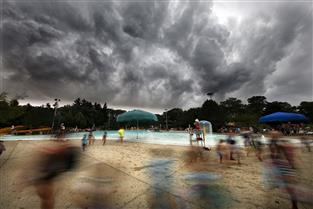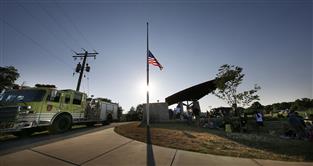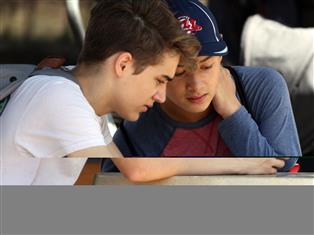It is positively time for football season, with camp opening this week. Before you head to the games, take a look at some of the rule changes - and some of the common misconceptions - to avoid confusion under the Friday night lights.
Players must sit out one play if their helmet comes off while the ball is live (unless helmet removal is attributed to a foul by the opponent).
The rule was one of eight changes made by the National Federation of State High School Associations in January, and it comes as a method of legislating proper application of the helmet.
"The problem we're seeing is for whatever reason, the kids they don't like the helmets to fit real tight," said Jeff Stern, senior editor of Referee Magazine, an operation based near Racine. "There's great potential for injury if they continue to play. You're going to have it fit right or sit out one play."
Town of Oconomowoc official Jeff Wiese said he noticed helmets coming off at the Division 3 college level usually once per game.
"The NCAA had the officials last season record each time a helmet came off, and they must have compiled the results and saw that it is happening too often," Wiese said. "In high school football, it probably happens about twice a season. It is a safety issue, and by making the player sit out a down if it comes off, it should help reinforce to the coaches and players that they have on properly fitted helmets that are strapped up tightly. If the helmet comes off as result of a foul by the opponent, such as a facemask, then the player does not have to sit out a down."
A receiver must now establish possession of the ball and make contact with the ground inbounds regardless of an opponent's action.
Previously, the mid-air "force out," which allowed for a legal catch if a receiver would have come down in bounds (in the judgment of the official) were it not for a defender pushing him out, still applied in varsity football. The measure has already been removed from college and pro football.
"It's taking one judgment call away from us, and nobody's disappointed in that," Stern said.
Rules were revised to prevent a kicking team from initiating contact (blocking) against members of the receiving team until the ball has broken the plane of the receiving team's restraining line, or until the kicking team is eligible to recover the free kick.
This prevents a situation where a first line of kicking team players clear out the first wave of receivers, opening the door for a second tier of players to recover an onside kick.
"When a receiver is looking down at the ground, in effect he's kind of defenseless," Stern said. "With the kicking team guys coming in and blasting them, there's great potential for injury. Now the kicking team can't make contact with receiving team until the ball has traveled 10 yards and touched the ground in either order, or if the receiving team touches ball before it goes 10 yards or initiates the contact."
Stern said the rule will make onside kicks less chaotic.
A horse apiece
One of the commonly misunderstood penalties is the "horse collar" tackle, a penalty for grabbing inside the collar behind the neck and dragging a player down backwards.
"A grab of the jersey high on the back or shoulder pad to bring the runner down usually gets coaches and fans excited because a lot of them don't know that the grab has to be inside the collar," Wiese said. "Also a grab inside the collar on the runner by itself is not a foul. You must have the pull backward or sideward that results in bringing the ball carrier down.
"The horse-collar foul got its name from the action of what happens when a horse gets its reins pulled back hard causing the horse's legs to crumple underneath him," he added. "As officials, we use the visual of the horse to help us rule on a horse-collar foul."
Common misconceptions
Even some more common rules continue to create confusion among onlookers, particularly those more versed in the college or pro game and unaware of the differences at the varsity level.
"There are so many rules in football compared to other sports," Merton official Bob Mallow said. "A lot of people think because they've played football, they know the rules, but that's not the case most of the time. A lot of the fans have no concept of different rules between high school, college and professional. They see something that isn't called, and parents get a little vociferous."
One of the biggest misconceptions, officials agreed, was the "uncatchable pass" stipulation that precludes a pass interference call in the NFL. There's no such thing as an "uncatchable pass" in high school.
"It's an unwritten type of language among good officials that when the ball is thrown away, you're probably going to hold your flag on pass interference," Stern said. "Some guys will say a rule is a rule. Some will let the defensive back know they can't do that again."
Mallow pointed out that the penalty is 15 yards from the previous spot, not a spot-of-foul penalty.
Another big one: touchbacks. Any ball breaking the plane of the goal line in the air, even if it was touched first (unless intentionally batted back, which will draw a flag), is a touchback.
"Constantly you'll see a player touching a ball that bounces at the five-yard line and goes into the end zone, and everyone thinks he has to come out with it," Stern said. "But the correct call is to kill the play. It's always about the ball. If it bounces at the two-yard line and it's over the goal line - even if a player is outside the goal line - it's in the end zone. You can even be standing on the goal line or half a yard into the goal line and reach back through the plane to the half yard line (to get the ball downed before the end zone)."
So that muffed punt that trickles back into the end zone? That's a touchback. Stern mentioned an "original momentum" exception, where a player backing up and catching the ball in the field of play, then backpedaling into the end zone with his original momentum, is eligible to return the ball. If he takes a knee, the ball will be spotted where it was caught in play.
More from Sports
- Volleyball: MVC Boys Club team takes third in volleyball nationals
- Wauwatosa Swordfish swim well in two meets
- Football: Milwaukee County Chargers battle elements for win
- Baseball: Seven Wauwatosa baseball players earn all-conference honors
- Wauwatosa West girls basketball coach Ashley Imperiale resigns
- Sports Notes: July 28, 2016
- Wauwatosa school district files lawsuit against WIAA over conference realignment
- Baseball: Michaelis leads Wauwatosa East past rival West in regional
- Football: Milwaukee County Chargers earn overtime win over Muskego
- Baseball: Wauwatosa East's season ends with regional final loss to Waukesha North













